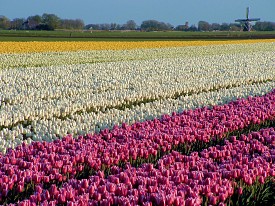Bulbs, Bulbs, Bulbs!
 Fall has officially begun, which means that one of my favorite times of the year is approaching. No, I'm not talking about the golden, warm, crisp days of early fall, although those are nice. I'm talking about bulb-planting time! I love bulbs with a passion, not least because so many are deer-resistant, and they're one of the few things I can plant with abandon (with some caveats) in my garden.
Fall has officially begun, which means that one of my favorite times of the year is approaching. No, I'm not talking about the golden, warm, crisp days of early fall, although those are nice. I'm talking about bulb-planting time! I love bulbs with a passion, not least because so many are deer-resistant, and they're one of the few things I can plant with abandon (with some caveats) in my garden.
There's also something rather delightful about sticking something in the ground in the fall, forgetting about it until spring, and then stumbling across those green shoots when they start coming up. Bulbs are often the first thing to bloom after the winter, ushering in the return of warm days, flowers, and time spent outdoors. These delightful heralds of spring are easy to plant, easy to take care of, and they make great cut flowers, to boot.
So let's talk about bulbs. Botanically speaking, bulbs are bulbous fleshy organs that store food, allowing plants to go dormant during the harsh winter weather. Once the soil begins to warm up and the days get longer, bulbs can begin to send out shoots. Some, like onions, are edible, while others are purely ornamental. Many reproduce by division (amaryllis, for example, can spread like wildfire if they're happy where they are), and they can withstand very tough conditions.
Ornamental bulbs, our concern today, include plants like daffodils (technically called narcissus), amaryllis, alliums (members of the onion family cultivated specifically for ornamental purposes), crocuses, hyacinths, lilies, irises, ipheion, galanthus, anemones, tulips...you're starting to get the picture. They come in a huge array of colors and cultivars; some are aromatic, others are double-petaled, and some are really quite exotic, like the ice cream tulip.
You can buy bulbs anytime (store them in a cool dry place), but fall is the best time, because then you can get them in the ground quickly. Garden supply stores are one resource, but you can also mail-order bulbs, which is an especially good choice if you want to make a bulk order. Many sellers offer a guarantee, assuring that their bulbs will sprout, but make sure to read the terms carefully so you understand how to file a claim if you get duds.
To plant bulbs, it helps to have a bulb planter, a nifty little tool that works kind of like a cookie cutter. You stick it straight into the soil to pull out a wedge, drop your bulb in (roots down, although bulbs can reorient themselves if needed), and push the soil over to cover. Bulb planters take a lot of the work out of the process and allow you to keep planting depths consistent. You should also scatter some bulb food in the hole to give the bulb some extra energy for the winter ahead, and encourage bright, beautiful blooming.
Then, ignore your bulbs until spring! Once they start to sprout, you may find it helpful to put up little flags to remind yourself not to run them over with the lawnmower. The flags are also useful at the end of the season, when all the leaves have died back and bulbs might be hard to find. You can use the flags to locate your bulbs, dig them up, divide them, and store them for fall planting.
Some useful bulb tips:
*If you have a gopher problem, be aware that some bulbs, like narcissus, actually aren't that appealing to gophers. They might move them around, but they won't eat them. (You can potentially use that to advantage to create a ring or girdle for vulnerable plants like young fruit trees -- the gophers won't want to pass the bulb barrier.) You can have your bulbs and enjoy them too.
That said, if you want to grow a cultivar that gophers love to eat (like tulips), you have a couple of options. One is to use sunken planters. Disposable plastic containers like the ones plants come in from the store can be ideal for this. Simply dig a hole big enough for the planter, seat it in the ground, fill it with soil, and plant your bulbs inside. The gophers won't be able to chew through the planter, and your bulbs will flourish.
You can also use an above-ground planter, of course. Beautiful pots of bulbs on the patio, porch, and around the house can be stunning in the spring, especially when the flowers are aromatic. Some bulbs can be forced to bloom in winter with a little sleight of hand, allowing you to enjoy handsome blooms and great smells in the darkest part of th eyear.
*If you have a deer problem, many deer-resistant bulb varieties are available, thankfully. They're often too bitter and unpleasant for deer to eat, even if they're desperate. Alliums, daffodils, Chionodoxa, Camassia, Colchicum, and even more have no appeal to deer. And they come in a huge array of cultivars, allowing you a great deal of flexibility when it comes to filling your garden with your most colorful dreams.
*Make sure to plant bulbs in well-drained soil. If they get soggy, they can start to rot, and they'll die. If your soil is clay-like or heavy, amend with sand, pearlite, and other materials to make it more airy.
Katie Marks writes for Networx.com.
Looking for a Pro? Call us (866) 441-6648

Landscaping Average Costs
Landscapers Experiences

Yard Clean Up Left Our Lawn Looking Fantastic

“Stealth” Tree Trimming Was An Incredibly Clean Job



